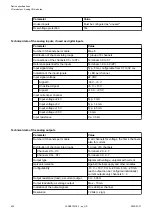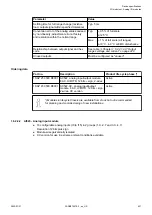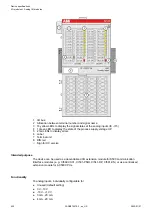
Terminals
Signal
Description
1.0 to 1.7
I0- to I7-
Negative poles of the first 8
analog inputs
2.0 to 2.7
I0+ to I7+
Positive poles of the first 8
analog inputs
3.0 to 3.7
I8- to I15-
Negative poles of the fol-
lowing 8 analog inputs
4.0 to 4.7
I8+ to I15+
Positive poles of the following
8 analog inputs
CAUTION!
The negative poles of the analog inputs are galvanically connected to each
other. They form an "Analog Ground" signal for the module. The negative poles
of the analog outputs are also galvanically connected to each other to form an
"Analog Ground" signal.
CAUTION!
There is no galvanic isolation between the analog circuitry and ZP/UP. There-
fore, the analog sensors must be galvanically isolated in order to avoid loops via
the ground potential or the supply voltage.
CAUTION!
Because of their common reference potential, analog current inputs cannot
be circuited in series, neither within the module nor with channels of other
modules.
For the open-circuit detection (cut wire), each analog input channel is pulled up
to "plus" by a high-resistance resistor. If nothing is connected, the maximum
voltage will be read in then.
The internal power supply voltage for the module's circuitry is carried out via the I/O bus
(provided by a communication interface module or a CPU). Thus, the current consumption from
24 V DC power supply at the terminals L+/UP and M/ZP of the CPU/communication interface
module increases by 2 mA per AI523.
The external power supply connection is carried out via the UP (+24 V DC) and the ZP (0 V DC)
terminals.
Device specifications
I/O modules > Analog I/O modules
2022/01/31
3ADR010278, 3, en_US
434














































